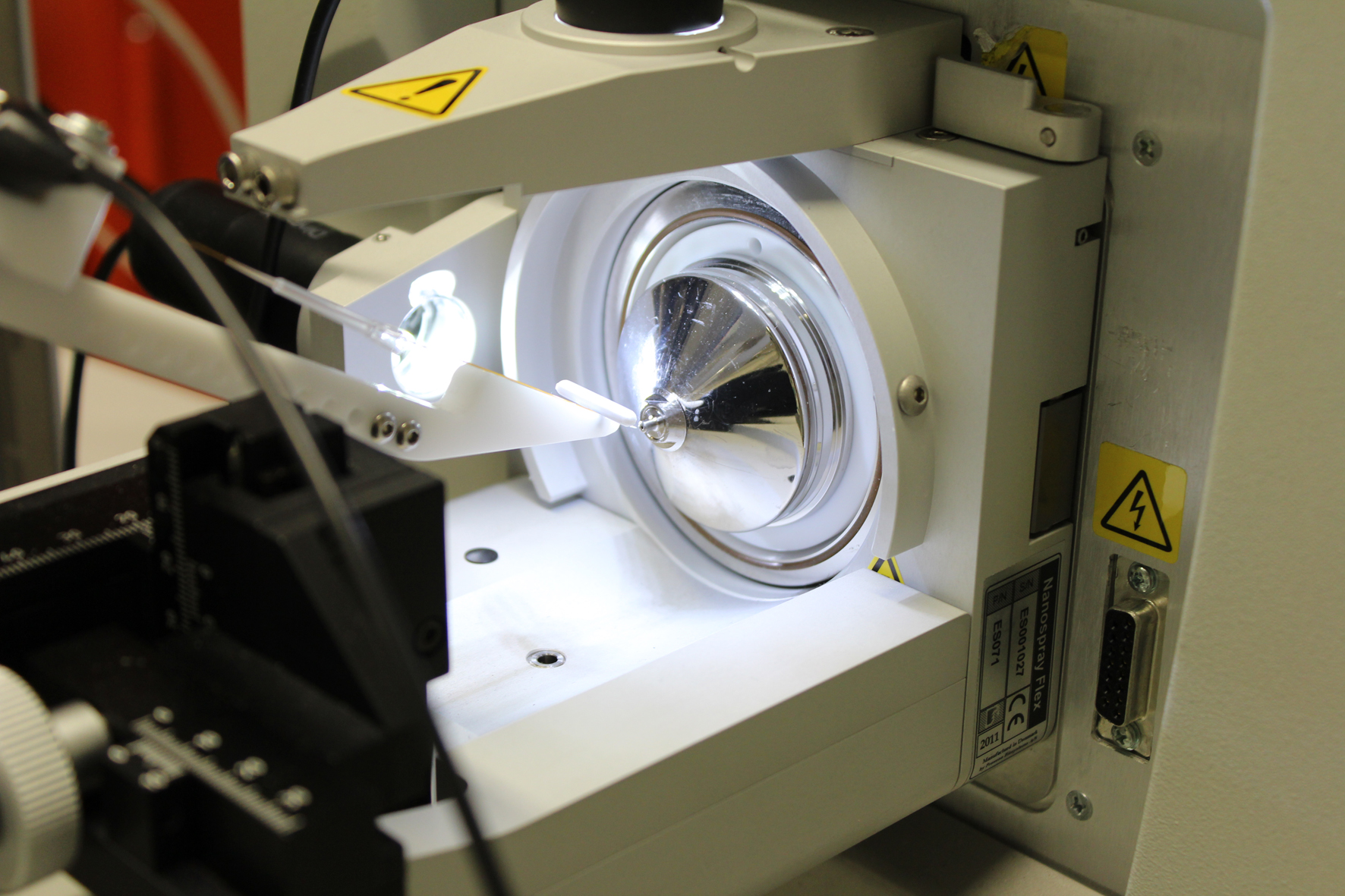Do gut bacteria have something to do with autism?
Autistic people have different gut microorganisms than non-autistic people. Researchers believe that a disturbed intestinal flora may play a role in developmental disorders of the brain such as autism. The emerging new field of metaproteomics could shed light onto the matter. A team led by Prof. Dr. Boris Macek from Tübingen has investigated the bacterial protein pool in the faeces of mice that display autistic behaviour.
 Prof. Dr. Boris Macek, Quantitative Proteomics, Director of the Proteome Center Tübingen © Jörg Abendroth
Prof. Dr. Boris Macek, Quantitative Proteomics, Director of the Proteome Center Tübingen © Jörg AbendrothResearchers have recently shown that germ-free mice develop autism-like symptoms when they are transplanted with faeces from autistic people1. Conversely, an initial small-scale study has shown that gut microbiota from the stool of healthy individuals seems to alleviate the behavioural problems and common gastrointestinal complaints of autistic children2. Although these results are promising, they still have to be confirmed and as Boris Macek, director of the Proteome Center Tübingen (PCT), says, "we still do not know exactly what effects intestinal flora might have on the autism symptoms at the molecular level."
It has been known for a while that the intestinal microbiome, comprising all bacteria and other microorganisms that colonise the intestine, breaks down non-digestible food, strengthens the immune system and protects us against pathogens. However the finding that the intestinal dwellers also communicate with the brain is relatively new. Intestinal bacteria release metabolic products, activate or inhibit inflammatory processes and even produce neurotransmitters. They most likely connect with the brain via the bloodstream, the immune system or the network of nerves around the intestines3.
Intestines of autistic individuals are more permeable to bacterial substances than those of healthy people
The altered intestinal flora in people with a tendency to autism spectrum disorders may cause their intestines to become more permeable to bacterial substances4. One hypothesis holds that this could lead to a subliminal chronic inflammation in the intestine and the brain. This, in turn, might influence early childhood development and the severity of autism symptoms, such as stereotyped behaviours, or the inability to build social relationships. It has already been demonstrated that intestinal inflammation is associated with developmental disorders such as autism.
Macek and researchers from England, France and Spain have explored this hypothesis in detail in the EU-funded project mNeuroINF. Using mice as models, Macek's team analysed the metaproteome in the mice's faeces. The metaproteome consists of all microbial proteins in the faecal sample. The mice are Down syndrome and fragile X syndrome animals, disorders characterised by brain defects that cause certain genetic defects and have parallels with autism.
Mice as well as people with these defects, i.e. disease-specific symptoms and autistic behaviours, were found to have a different intestinal flora from that of healthy people as well as suffering from brain inflammation. "There are not many autism mouse models," explains Macek. However, there is not just one type of autism; autism is a spectrum of disorders with different symptoms and degrees of severity. It is difficult to diagnose an autistic disorder as the specific causes of autism spectrum disorders have yet to be found.
Glutamate might interfere with brain development
Nevertheless, the Tübingen researchers have made an interesting discovery that could also apply to autism: "We have seen in Down syndrome mice that enzymes which produce glutamate are upregulated and enzymes which degrade glutamate are downregulated compared to normal mice," says Macek. This is in line with a previous study which found that children with autism have elevated blood glutamate levels5. Glutamate is an important excitatory neurotransmitter in the brain. However, large quantities of glutamate damage nerve cells and it is thought that glutamate may be a possible cause of neuronal developmental disorders.
The proteome researchers found no direct indication of dysregulated proteins that play a role in an immune response in any of the faecal samples of the two mouse models. However, the researchers were able to show in cell cultures that microbial metabolites from the intestine definitely had an influence on inflammations of the brain. For example, trimethylamine, which is often produced as a result of microbial food decomposition in the gut and has also been found in the brain, was demonstrated to inhibit inflammation in certain immune cells in the brain. Although the individual pieces of the puzzle do not yet give an overall picture of the molecular pathways through which the gut microbiome influences brain development disorders, they nevertheless show that the researchers may be on the right track. The project partners are currently preparing a publication detailing their findings.
The researchers will now have to prove that glutamate and trimethylamine actually stem from gut bacteria. "This is not that easy because the human metabolism, or in the case of the mouse, the murine metabolism, also produces glutamate," says Macek. The same could apply to trimethylamine. If proof can be provided in animal experiments, the researchers will then have to substantiate their findings in humans.
Metaproteomics complements metagenomics
 In metaproteomics, proteins of the microbial community of the gut, for example, are isolated, digested with enzymes, ionised and characterised using mass spectrometry. Researchers can thus identify thousands of proteins from complex samples in a short time. © Boris Macek
In metaproteomics, proteins of the microbial community of the gut, for example, are isolated, digested with enzymes, ionised and characterised using mass spectrometry. Researchers can thus identify thousands of proteins from complex samples in a short time. © Boris MacekWhen it comes to uncovering the role of the gut microbiome in disease, researchers around the world are at the very start of their investigations, not only for autism spectrum disorders but for other areas as well. Thanks to large metagenome projects, in which researchers investigate the collective genome of all microorganisms of a specific biological community, they now know the most common intestinal bacteria and the function of many of their genes. "However, what we cannot find out with metagenomics is, which of the microbial genes are actually active," says Macek, adding that it is therefore best to look at the gene products, i.e. proteins in most cases.
"We have established a workflow that allows us to use mass spectrometry to identify up to 30,000 different proteins from mouse faeces. That means we can compete with the best laboratories in the world," says Macek proudly. A major challenge for metaproteomics is the fact that gut microbiota samples usually contain low numbers of individual protein groups. This is because several hundred different bacterial species, each with a different protein pool, colonise the intestine. And unlike DNA, proteins cannot be amplified in the laboratory to increase the chances of detection. Macek warns: "We have to be very careful about how we prepare the samples. Different methods can affect the composition of the microbiome detected."
There are only a few research groups worldwide working exclusively on metaproteomics. It was also the first metaproteome project for proteomic expert Macek, who had previously been mainly interested in protein profiles of tumours or certain antibiotic-resistant bacteria. "Proteomics always has a built-in delay, because we first need the genomic data for comparison," says Macek.
Macek explains that although it is possible to identify individual proteins from the microbial protein pool, it is difficult to find out the species that they actually come from. "When I see in the metagenome data that, for example, the Prevotella bacterium is most abundant in a sample and, according to metaproteome data, an aldolase is the most abundant enzyme in the sample, then the enzyme probably, but not necessarily, originates from this species," explains Macek. He points out that it is also possible to measure all microbial metabolites of the sample, the metabolome, and analyse whether the enzymes present actually produce certain metabolic products. Combining all of the omics data, it will be easier in the future to identify from the bacteria’s vast metabolic network those bacterial pathways that may be important to disease and health. Maybe this will eventually lead to the development of a therapy for autism spectrum disorders.